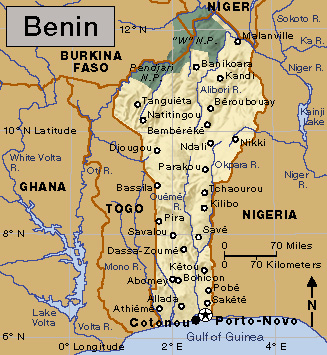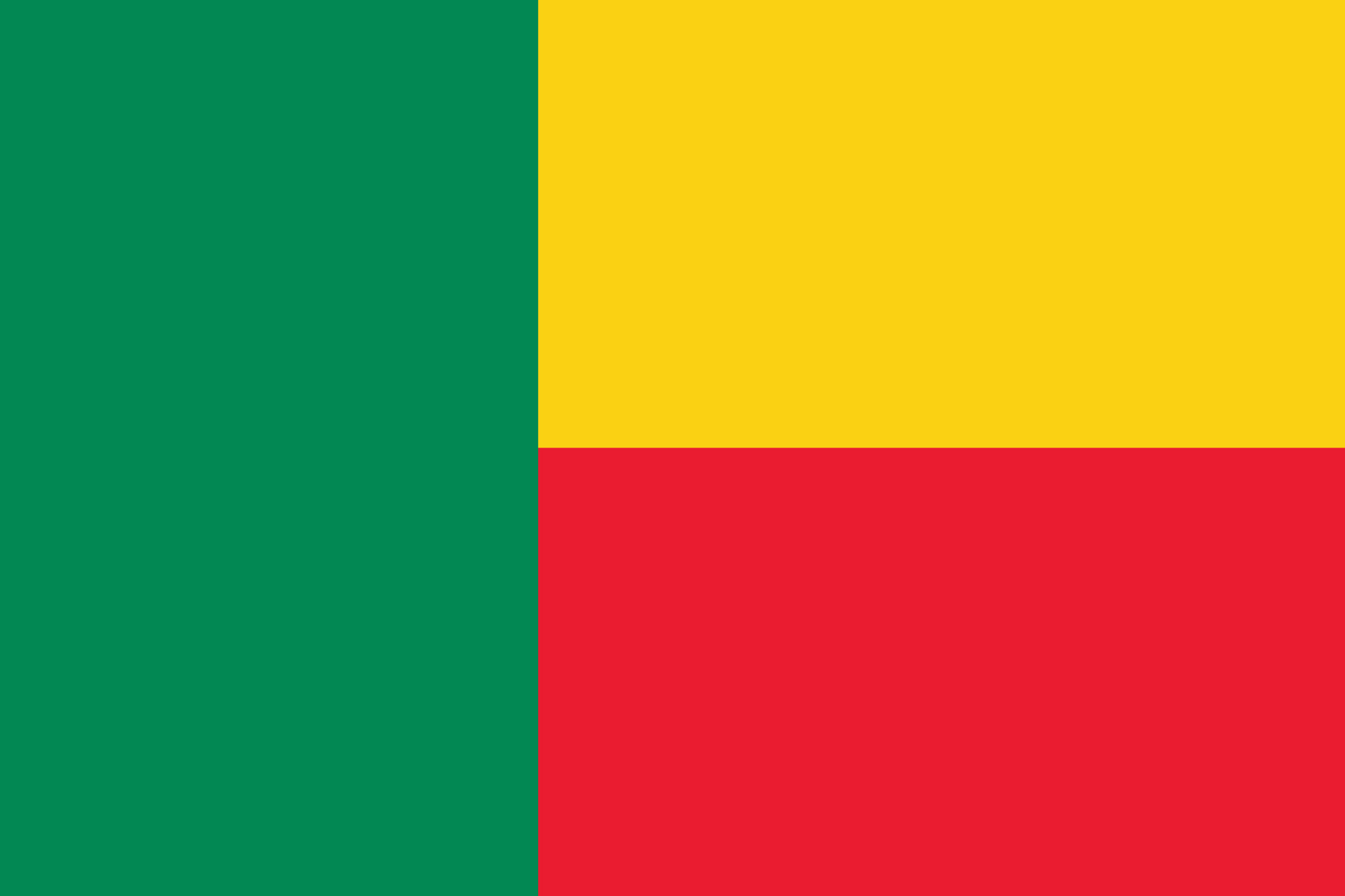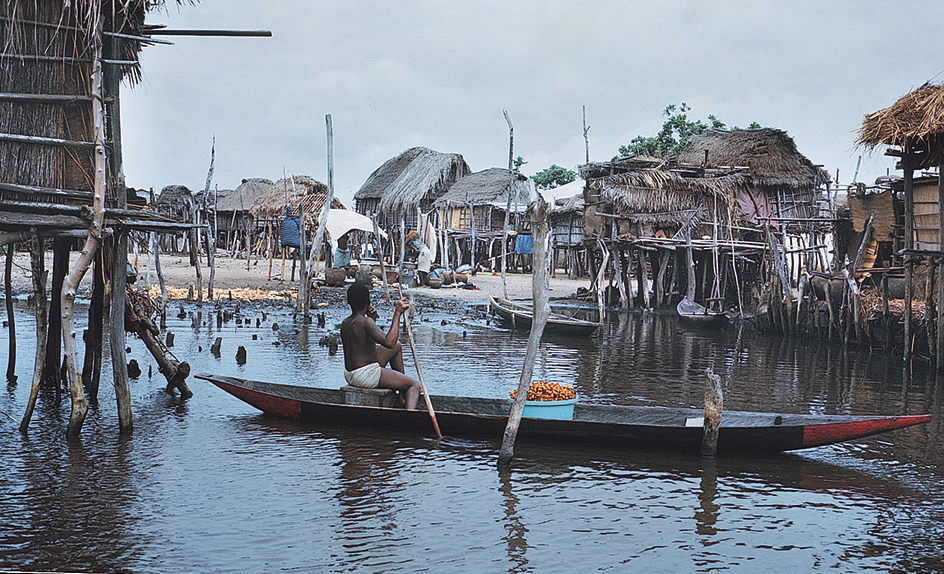Benin << beh NEEN >> is a country on the west coast of Africa. Long and narrow, Benin extends 415 miles (668 kilometers) inland from the Gulf of Guinea. Most of the people of Benin are farmers.

Benin was formerly a territory in French West Africa. It became independent in 1960. The country’s name in French, the official language, is République du Benin. The nation was called Dahomey until 1975. Porto-Novo is the capital, but most of the government activity takes place in Cotonou. Cotonou is the largest city, main port, and commercial center of the country.
Government.
Benin is a republic. A president heads the government. The people elect the president to a five-year term. The president appoints a Council of Ministers. The president and Council carry out the operations of the government. A 109-member National Assembly is Benin’s lawmaking body. The people elect Assembly members to five-year terms.
People.
Benin’s population consists of about 60 ethnic groups. The largest group, which consists of the closely related Fon and Adja, makes up about 60 percent of the population. This group and the Yoruba, who make up about 10 percent, dwell in southern Benin. The Bariba, who also make up about 10 percent, are the most populous northern group. Most of Benin’s people live in simple houses built by hand. However, some people, particularly in the cities, live in concrete homes.


The women of Benin wear brightly colored dresses. A popular garment for men is the agbade, which includes trousers, short jacket, and full robe. Many people, particularly in southern Benin, wear clothing that is similar to that worn in the United States and Canada.
About 40 percent of Benin’s people are Christians, and about 25 percent are Muslims. Most of the Christians live in southern Benin. Most Muslims live in the north. Many Beninese practice animism, the belief that all things in nature have spirits. Most of this group follow a form of animism known as Vodou (sometimes called Voodoo).
A law requires children ages 6 to 11 to attend school. But the law is not strictly enforced, and many children do not attend school. About 60 percent of Benin’s adult population cannot read or write.
Land and climate.
The coast of Benin is flat and sandy, and has no natural harbors. Ships must anchor offshore, except at the artificially created port of Cotonou. Beyond the lagoons that lie behind the coastal strip, the country is flat and forested. About 50 miles (80 kilometers) inland is a great marsh. Benin’s highest elevation, about 2,000 feet (610 meters), is in the Atacora Mountains in the northwest. The Ouémé River, the country’s longest river, flows 280 miles (451 kilometers) into the Gulf of Guinea.
Southern Benin has a hot, humid climate. Rainy seasons occur in the south from April to July and from September to November. Northern Benin has less humidity and greater changes in daily temperatures. In the north, the rainy season lasts from April to October. Rainfall averages 20 inches (51 centimeters) a year in the southeast, 50 inches (130 centimeters) in the central section, and 35 inches (89 centimeters) in the north.
Economy.
Benin is mainly an agricultural country. Its food crops include beans, cashews, cassava, corn, peanuts, tomatoes, and yams. The people raise cattle, chickens, goats, pigs, and sheep. Cotton is the country’s leading export. Benin also exports products from its palm trees, such as palm oil and palm kernels. The oil from the kernels is used in soap and margarine. Benin imports food and petroleum products. Benin trades with China, France, India, and Togo.
The south has a few industrial plants. Benin produces cement and other construction materials, food products, and textiles. It mines some clay and limestone.
Benin provides an outlet to the sea for Niger by rail and road. It is a crossroads for coastal road traffic from Nigeria to Ghana. Cotonou has the country’s main port and an international airport.
History.
During the 1100’s or 1200’s, several African kingdoms were founded in the region that is now Benin. By the 1600’s, the kingdom of Dahomey, with Abomey its capital, controlled the area. Europeans began to establish slave-trading posts along the coast at about this time. The power of the king of Dahomey was based largely on the slave trade.
The palm oil trade replaced the slave trade during the 1800’s. In 1851, France signed a trade agreement with the kingdom of Dahomey. Soldiers of the kingdom attacked French trading posts in 1892, but the French defeated them. France took over the area and made it part of French West Africa in 1904. The French built railroads and roads and encouraged coffee growing. Under the 1946 French constitution, the region became an overseas territory of France. The French gave it self-government in 1958. Benin, then called Dahomey, became a fully independent nation in August 1960. In 1975, the government changed the country’s name from Dahomey to Benin.
Social unrest and political rivalries have led to frequent changes in Benin’s government since the country’s independence in 1960. Military leaders overthrew the government several times during the 1960’s and 1970’s. In May 1970, a civilian government was formed, headed by a three-man presidential council. In October 1972, a military government again took control of the country. This government, headed by army leader Mathieu Kérékou, took control of Benin’s most important businesses, formed its own political party, and banned all other political parties.
Political and social unrest, led by students and government workers, marked the late 1980’s. In early 1990, members of Benin’s government and of opposing groups dissolved Kérékou’s government and legalized all political parties. They formed a temporary government with Nicéphore Soglo as prime minister. Kérékou remained as president, but Soglo became Benin’s leader. The temporary government served until early 1991, when Soglo was elected president and a new legislature was chosen. Benin’s new government ended nearly all governmental control of businesses. Kérékou was elected president in 1996 and reelected in 2001.
In 2006, Kérékou retired and Thomas Yayi Boni, a former banker, was elected to succeed him. Yayi was reelected in 2011. Businessman Patrice Talon was elected as president in 2016, and again in 2021.
